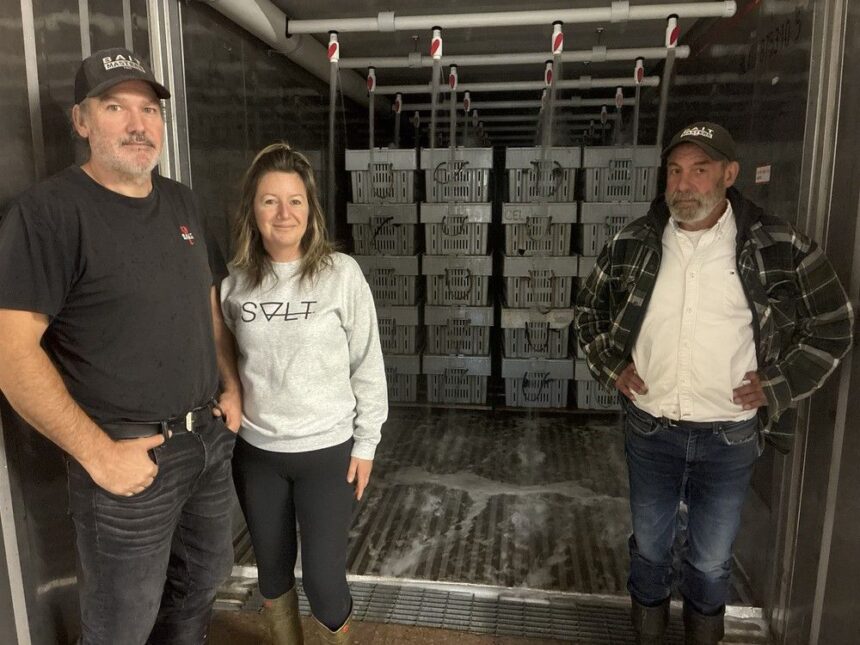Bait Masters, located in Nine Mile Creek, recently had new holding tanks created by sustainable design engineering students at UPEI. Bait Masters is owned by Wally MacPhee, left, and Mark Prevost, right. With them is employee Melissa MacPhee. Photo by Dave Stewart /The GuardianArticle contentNINE MILE CREEK, P.E.I. — A P.E.I. seafood company has come up with a new way to store lobsters.THIS CONTENT IS RESERVED FOR SUBSCRIBERS ONLY.Subscribe now to access this story and more:Unlimited access to the website and appExclusive access to premium content, newsletters and podcastsFull access to the e-Edition app, an electronic replica of the print edition that you can share, download and comment onEnjoy insights and behind-the-scenes analysis from our award-winning journalistsSupport local journalists and the next generation of journalistsSUBSCRIBE TO UNLOCK MORE ARTICLES.Subscribe or sign in to your account to continue your reading experience.Unlimited access to the website and appExclusive access to premium content, newsletters and podcastsFull access to the e-Edition app, an electronic replica of the print edition that you can share, download and comment onEnjoy insights and behind-the-scenes analysis from our award-winning journalistsSupport local journalists and the next generation of journalistsRegister to unlock more articles.Create an account or sign in to continue your reading experience.Access additional stories every monthShare your thoughts and join the conversation in our commenting communityGet email updates from your favourite authorsSign In or Create an AccountorArticle contentBait Masters credits students at the UPEI engineering department for designing a rainfall storage tank that makes it easier to load and unload pallets of lobsters while keeping them wet and healthy.Article contentArticle contentMark Prevost, one of the owners at Bait Masters, said the tank can store 260 crates or 26,000 pounds of lobsters.Article contentArticle content“Now, we’ve tripled our capacity with the same amount of labour,” Prevost said during a tour of the new tank on Oct. 20. “If we would have went with more traditional tanks we would have to increase the labour. That’s double the time. This new tank isn’t going to take any more man hours to operate.”Article contentPrevost and his partner, Wally MacPhee, first approached Innovation P.E.I. with the idea, and were told to contact UPEI. Innovation P.E.I. had a program that paid 50 per cent of the $7,500 design cost. Bait Masters paid $200,000 to build the tank as a prototype.Article content“We had the idea for the tank, but we needed engineer tank drawings for the concept and that gets really expensive,” Prevost said, adding that tendering the cost out to a private sector firm would have cost $80,000.Article content Wally MacPhee’s Bait Masters Inc. plant in Nine Mile Creek has been producing these bail sausages in its $1.4-million facility in Nine Mile Creek since April 2021. MacPhee, who co-owns the plant, has developed a new holding tank with the help of engineering design students at UPEI. Photo by Dave Stewart /The GuardianArticle contentStaffing levelsArticle contentMacPhee said Bait Masters will be doing short-term holding in the tank.Article contentArticle content“If you’re going to store lobsters for months on end, you wouldn’t use a tank like (ours),” MacPhee said. “We’re short term, like a wet fridge. It takes a lot of people to load it and unload it. With this one here, you can put three times the volume in it and one person can handle it all. We’re pretty busy … dealing with the loading and unloading is pretty time-consuming.”Article contentArticle contentTraditionally, lobsters are stored in tanks of water. With this new system, the crustaceans are put in a tank and the constant rainfall keeps them wet and healthy. The rain is recycled at the bottom of the tank and reused.Article contentPrevost said some people might be under the impression this means fewer jobs at the Nine Mile Creek plant, but this is not the case.Article content“This just means we’re doing more volume with the same amount of people that get paid more,” Prevost said. “Some people think that automation means that people are starting to lose jobs because of it. In our case, we’re able to pay a better rate. There are no layoffs. We move more product in less time and make more money.”
P.E.I. seafood company finds success with new lobster holding tank












